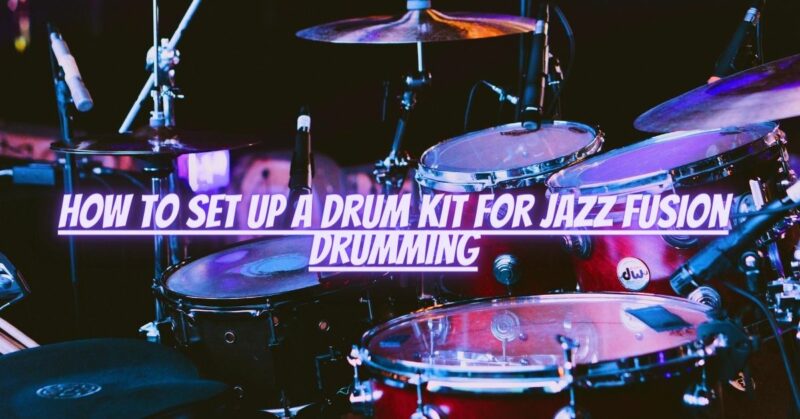Jazz fusion drumming requires a unique combination of versatility, dynamics, and technical proficiency. Crafting the ideal drum kit setup is crucial to meet the demands of this genre, which seamlessly blends elements of jazz, funk, rock, and other styles. In this article, we will guide you through the process of setting up a drum kit specifically tailored for jazz fusion drumming. From drum sizes and materials to cymbal choices and auxiliary percussion, we’ll cover the key considerations to help you create a versatile and expressive setup that meets the demands of this exciting genre.
- Drum Sizes and Materials: Jazz fusion drumming often calls for a balance between warmth and projection. Consider a 4 or 5-piece drum kit with a smaller bass drum size, such as 20 or 22 inches, for focused and punchy low-end response. Opt for tom sizes ranging from 10 to 14 inches, allowing for quick and agile transitions between different melodic ideas. Maple and birch are popular shell materials due to their balanced tonal qualities that blend warmth and projection.
- Snare Drum Selection: Selecting the right snare drum is crucial for jazz fusion drumming. Look for a versatile snare drum that can deliver a wide range of sounds. Consider a 14×5 or 14×6.5-inch snare drum made of wood, such as maple or birch, for warmth and sensitivity. A drum with a combination of sensitivity, projection, and articulation will enable you to execute intricate patterns and dynamic accents with ease.
- Cymbal Choices: Cymbals play a vital role in jazz fusion drumming, offering a wide sonic palette for expression. Look for cymbals that provide a balanced blend of warmth, complexity, and articulation. Choose a versatile ride cymbal with a medium weight and clear stick definition, complemented by a subtle shimmer in the wash. For hi-hats, select a pair that offers a crisp and articulate response, allowing for precise chick sounds and dynamic control. Consider adding a variety of crash cymbals, ranging from thin to medium weights, to provide different tonal options for accents and fills.
- Auxiliary Percussion: In jazz fusion, auxiliary percussion can add depth and texture to your playing. Consider incorporating instruments such as a cowbell, tambourine, shaker, or woodblock into your setup. These instruments can be mounted on a separate stand or attached to existing hardware using clamp-on attachments. Experiment with different auxiliary percussion options to enhance your grooves and add exciting rhythmic layers to your playing.
- Drumhead Selection: Choosing the right drumheads is essential for achieving the desired tone and response in jazz fusion drumming. Opt for coated drumheads on the snare drum to achieve a warm, focused sound with enhanced sensitivity. For the toms, consider clear drumheads that provide a balance of warmth, sustain, and projection. Experiment with different drumhead brands and models to find the ones that suit your desired tonal characteristics.
- Drum Tuning: Tuning your drums appropriately is crucial to achieving the desired sound in jazz fusion drumming. Aim for a medium to medium-high tuning on the toms and snare drum to strike a balance between warmth and clarity. Ensure that each drumhead is tensioned evenly, and experiment with different tunings to find the sweet spot that suits the style of jazz fusion you are playing.
- Ergonomics and Comfort: Consider the ergonomics and comfort of your drum setup, especially during extended playing sessions. Adjust the drum and cymbal heights, angles, and positions to ensure optimal reach and posture. Use adjustable hardware and accessories, such as multi-clamps and extension arms, to position your drums and cymbals precisely where you need them. This setup allows for effortless movement around the kit and reduces the risk of strain or discomfort during performances.
- Experiment and Personalize: Remember that setting up a drum kit is a personal process. While guidelines can be helpful, don’t be afraid to experiment and tailor the setup to your playing style and preferences. Explore different configurations, add or remove components, and adjust the positioning of drums and cymbals until you find a setup that inspires your creativity and allows for effortless expression.
Conclusion: Setting up a drum kit for jazz fusion drumming involves careful consideration of drum sizes and materials, snare drum selection, cymbal choices, auxiliary percussion, drumhead selection and tuning, ergonomics and comfort, and personalization. By selecting drums that offer a balance between warmth and projection, choosing versatile snare drums, opting for cymbals that provide a wide sonic palette, incorporating auxiliary percussion, using appropriate drumheads and tuning, ensuring ergonomic positioning, and personalizing your setup to fit your playing style, you can create a drum kit perfectly suited for jazz fusion drumming. With the right setup, you’ll have the tools you need to explore the intricate rhythms and dynamic expressions that define this genre.


